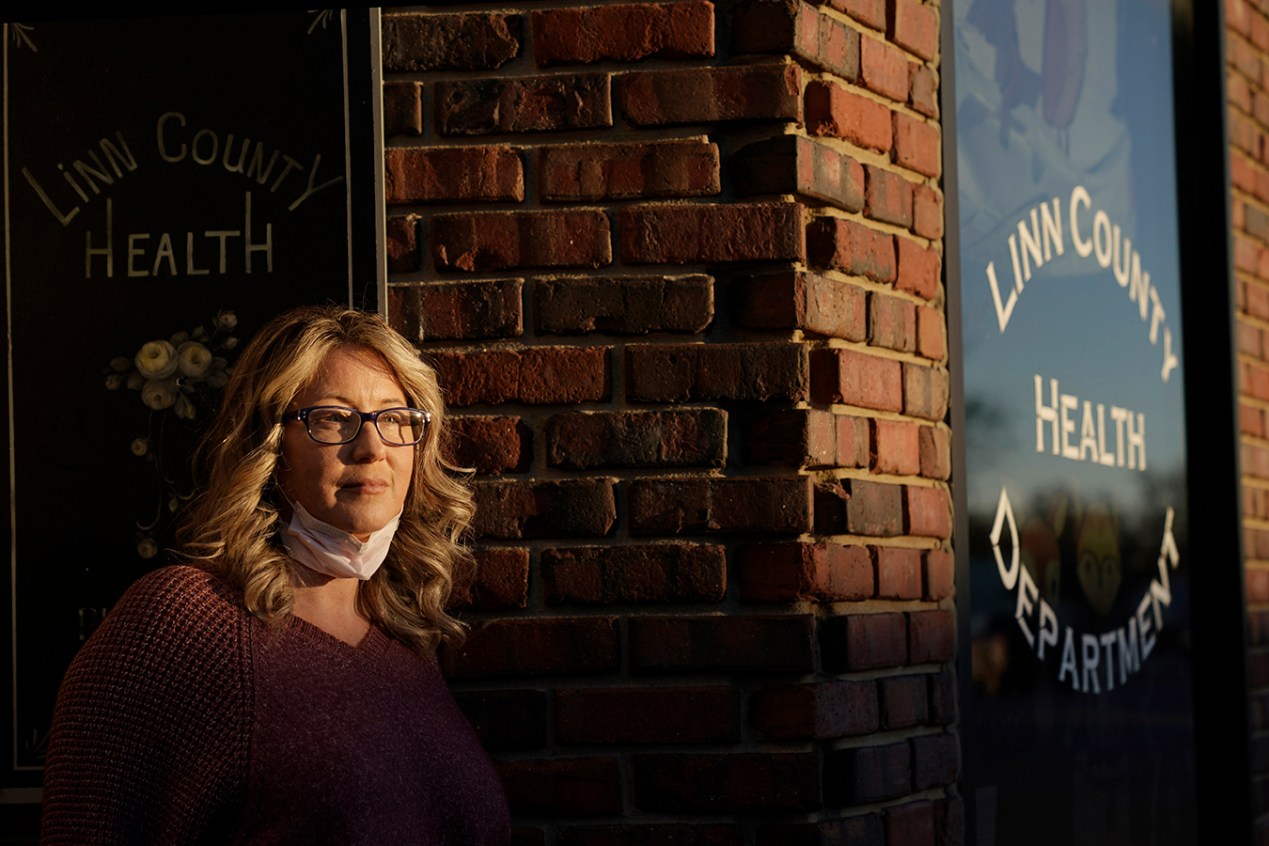[Update: This article was revised at 1:15 p.m. ET on Dec. 15, 2020, to reflect the resignation of Dr. Gianfranco Pezzino, the health officer in Shawnee County, Kansas.]
Tisha Coleman has lived in close-knit Linn County, Kansas, for 42 years and never felt so alone.
As the public health administrator, she’s struggled every day of the coronavirus pandemic to keep her rural county along the Missouri border safe. In this community with no hospital, she’s failed to persuade her neighbors to wear masks and take precautions against COVID-19, even as cases rise. In return, she’s been harassed, sued, vilified — and called a Democrat, an insult in her circles.
Even her husband hasn’t listened to her, refusing to require customers to wear masks at the family’s hardware store in Mound City.
“People have shown their true colors,” Coleman said. “I’m sure that I’ve lost some friends over this situation.”
By November, the months of fighting over masks and quarantines were already wearing her down. Then she got COVID-19, likely from her husband, who she thinks picked it up at the hardware store. Her mother got it, too, and died on Sunday, 11 days after she was put on a ventilator.
Across the U.S., state and local public health officials such as Coleman have found themselves at the center of a political storm as they combat the worst pandemic in a century. Amid a fractured federal response, the usually invisible army of workers charged with preventing the spread of infectious diseases has become a public punching bag. Their expertise on how to fight the coronavirus is often disregarded.
Some have become the target of far-right activists, conservative groups and anti-vaccination extremists, who have coalesced around common goals — fighting mask orders, quarantines and contact tracing with protests, threats and personal attacks.
The backlash has moved beyond the angry fringe. In the courts, public health powers are being undermined. Lawmakers in at least 24 states have crafted legislation to weaken public health powers, which could make it more difficult for communities to respond to other health emergencies in the future.
“What we’ve taken for granted for 100 years in public health is now very much in doubt,” said Lawrence Gostin, an expert in public health law at Georgetown University in Washington, D.C.
It is a further erosion of the nation’s already fragile public health infrastructure. At least 181 state and local public health leaders in 38 states have resigned, retired or been fired since April 1, according to an ongoing investigation by The Associated Press and KHN. According to experts, this is the largest exodus of public health leaders in American history. An untold number of lower-level staffers has also left.
“I’ve never seen or studied a pandemic that has been as politicized, as vitriolic and as challenged as this one, and I’ve studied a lot of epidemics,” said Dr. Howard Markel, a medical historian at the University of Michigan. “All of that has been very demoralizing for the men and women who don’t make a great deal of money, don’t get a lot of fame, but work 24/7.”
One in 8 Americans — 40 million people — lives in a community that has lost its local public health department leader during the pandemic. Top public health officials in 20 states have left state-level departments, including in North Dakota, which has lost three state health officers since May, one after another.
Many of the state and local officials left due to political blowback or pandemic pressure. Some departed to take higher-profile positions or due to health concerns. Others were fired for poor performance. Dozens retired.
KHN and AP reached out to public health workers and experts in every state and the National Association of County and City Health Officials; examined public records and news reports; and interviewed hundreds to gather the list.
Collectively, the loss of expertise and experience has created a leadership vacuum in the profession, public health experts say. Many health departments are in flux as the nation rolls out the largest vaccination campaign in its history and faces what are expected to be the worst months of the pandemic.
“We don’t have a long line of people outside of the door who want those jobs,” said Dr. Gianfranco Pezzino, health officer in Shawnee County, Kansas, who had decided to retire from his job at the end of the year, he said, because he’s burned out. “It’s a huge loss that will be felt probably for generations to come.”
But Pezzino could not even make it to Dec. 31. On Monday, after county commissioners loosened restrictions, he immediately stepped down.
“You value the pressure from people with special economic interests more than science and good public health practice,” he wrote in a letter to the commissioners. “In full conscience I cannot continue to serve as the health officer for a board that puts being able to patronize bars and sports venues in front of the health, lives and well-being of a majority of its constituents.”
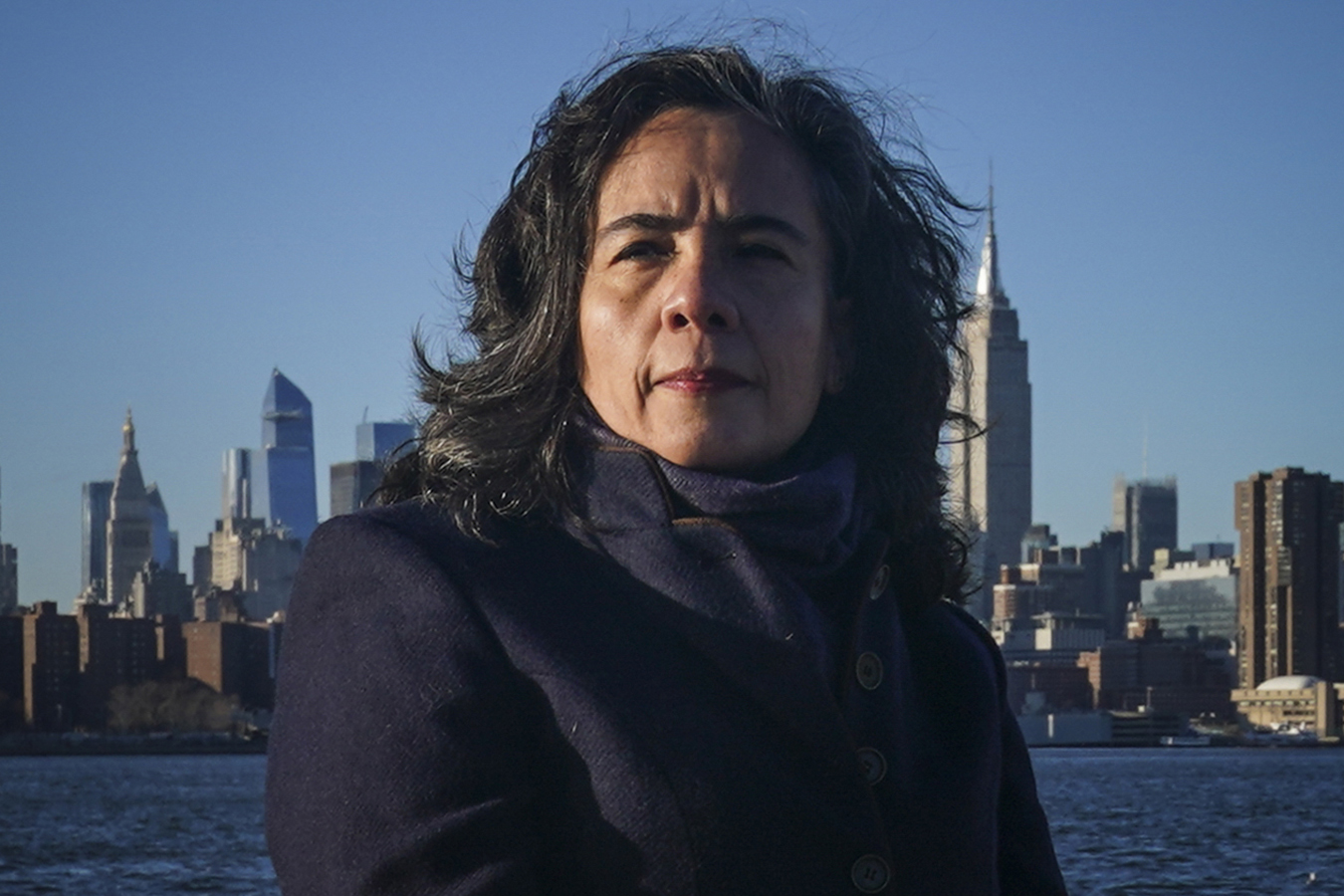
“Our job has been to make sure that things don't go wrong. And when you have that kind of a mission, you become invisible, and people take for granted the work that you do, and then they may not understand the work that you do. …
“My concern for public health front-line [workers] is the same as my concern for health care workers, front line. Right? The only difference in my mind is that health care workers are more visible in terms of the degree to which, you know, they're at a breaking point. But public health workers are at that same breaking point, but they're just more invisible.”(AP Photo/Bebeto Matthews)
Existing Problems
The departures accelerate problems that had already weakened the nation’s public health system. AP and KHN reported that per capita spending for state public health departments had dropped by 16%, and for local health departments by 18%, since 2010. At least 38,000 state and local public health jobs have disappeared since the 2008 recession.
Those diminishing resources were already prompting high turnover. Before the pandemic, nearly half of public health workers said in a survey they planned to retire or leave in the next five years. The top reason given was low pay.
Such reduced staffing in departments that have the power and responsibility to manage everything from water inspections to childhood immunizations left public health workforces ill-equipped when COVID-19 arrived. Then, when pandemic shutdowns cut tax revenues, some state and local governments cut their public health workforces further.
“Now we’re at this moment where we need this knowledge and leadership the most, everything has come together to cause that brain drain,” said Chrissie Juliano, executive director of the Big Cities Health Coalition, which represents leaders of more than two dozen public health departments.
Politics as Public Health Poison
Public health experts broadly agree that masks are a simple and cost-effective way to reduce the spread of COVID-19 and save lives and livelihoods. Scientists say that physical distancing and curtailing indoor activities can also help.
But with the pandemic coinciding with a divisive presidential election, simple acts such as wearing a mask morphed into political statements, with right-wing conservatives saying such requirements stomped on individual freedom.
On the campaign trail, President Donald Trump ridiculed President-elect Joe Biden for wearing a mask and egged on armed people who stormed Michigan’s Capitol to protest coronavirus restrictions by tweeting “LIBERATE MICHIGAN!”

Coleman, a Christian and a Republican, said that’s just what happened in Linn County. “A lot of people are shamed into not wearing a mask ... because you’re considered a Democrat,” she said. “I’ve been called a ‘sheep.’”
The politicization has put some local governments at odds with their own health officials. In California, near Lake Tahoe, the Placer County Board of Supervisors voted to end a local health emergency and declared support for a widely discredited “herd immunity” strategy, which would let the virus spread. The idea is endorsed by many conservatives, including former Trump adviser Dr. Scott Atlas, as a way to keep the economy running, but it has been denounced by public health experts who say millions more people will unnecessarily suffer and die. The supervisors also endorsed a false conspiracy theory claiming many COVID-19 deaths are not actually from COVID-19.
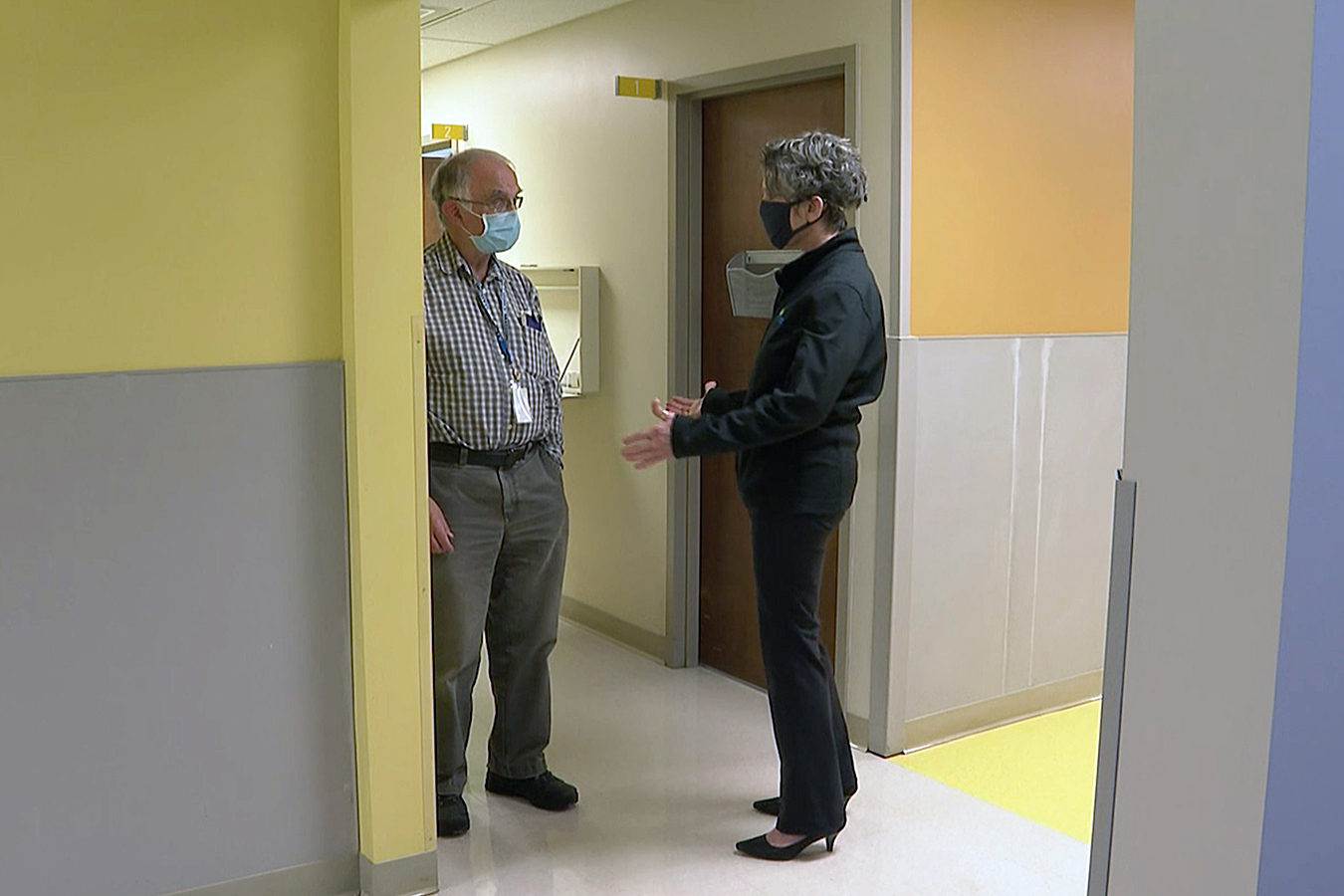
“I get hate emails. They say, 'We’re going to take you down like the governor,' and you know what that means, with the kidnapping threat. But among the most concerning, I received an envelope at my home. Typed. My name and my home address. And I opened it up and inside it is an 8.5-by-11 piece of paper that has a Nazi soldier wearing a Nazi swastika, and a Democratic donkey. It said: 'It’s not facism when we do it.’ ...
“I could retire any time. I’m going to do the right thing.”(AP Photo/Mike Householder)
The meeting occurred just days after county Public Health Officer Dr. Aimee Sisson explained to the board the rigorous standards used for counting COVID-19 deaths. Sisson quit the next day.
In Idaho, protests against public health measures are intensifying. Hundreds of protesters, some armed, swarmed health district offices and health board members’ homes in Boise on Dec. 8, screaming and blaring air horns. They included members of the anti-vaccination group Health Freedom Idaho.
Dr. Peter Hotez, dean of the National School of Tropical Medicine at Baylor College of Medicine, has tracked the anti-vaccine movement and said it has linked up with political extremists on the right, and taken on a larger anti-science role, pushing back against other public health measures such as contact tracing and physical distancing.
Members of a group called the Freedom Angels in California, which sprung up in 2019 around a state law to tighten vaccine requirements, have been organizing protests at health departments, posing with guns and calling themselves a militia on the group’s Facebook page.
The latest Idaho protests came after a July skirmish in which Ammon Bundy shoved a public health employee who tried to stop him and his maskless supporters from entering a health meeting.
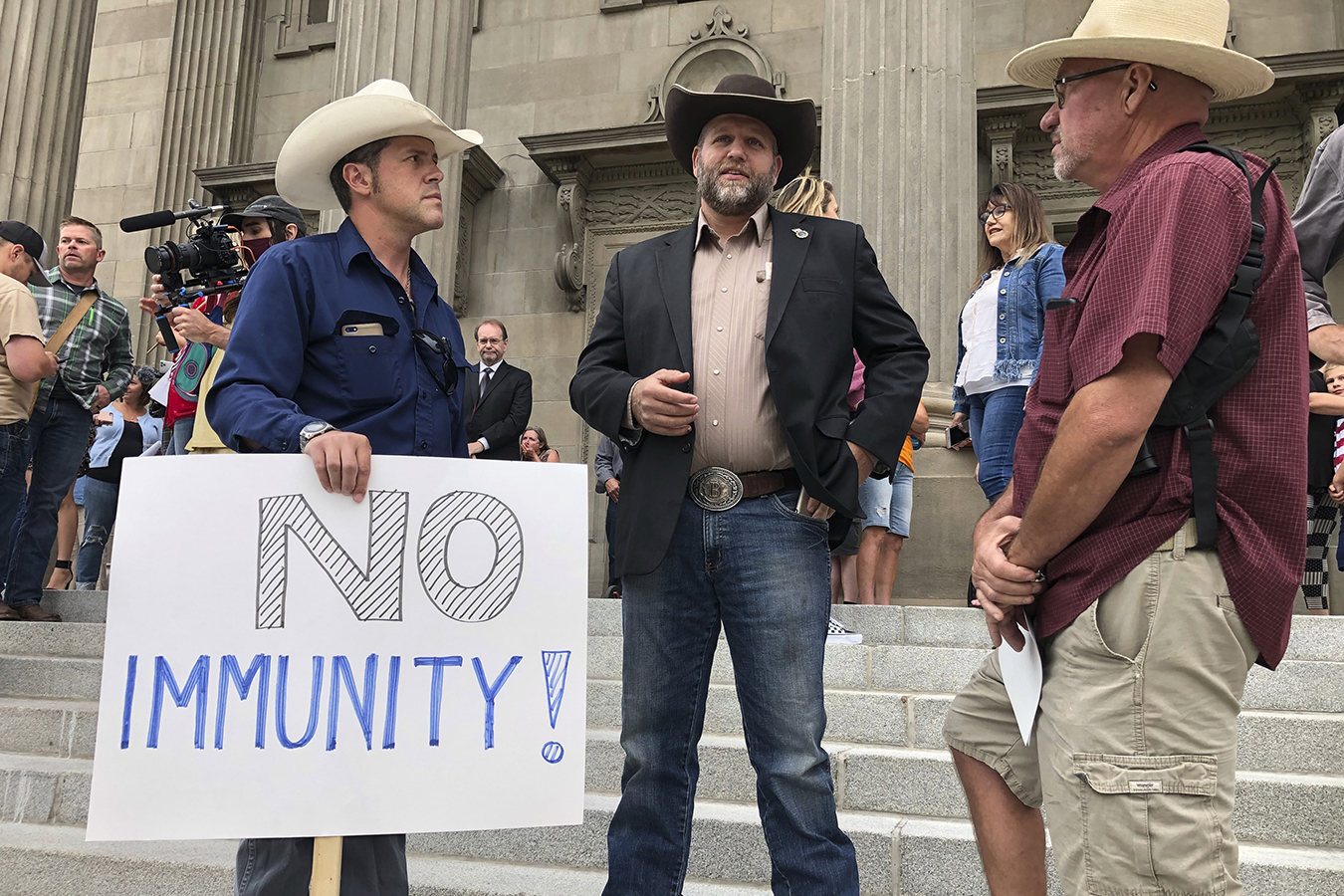
Bundy, whose family led armed standoffs against federal agents in 2014 and 2016, has become an icon for paramilitary groups and right-wing extremists, most recently forming a multistate network called People’s Rights that has organized protests against public health measures.
“We don’t believe they have a right to tell us that we have to put a manmade filter over our face to go outside,” Bundy said. “It’s not about, you know, the mandates or the mask. It’s about them not having that right to do it.”
Kelly Aberasturi, vice chair for the Southwest District Health, which covers six counties, said the worker Bundy shoved was “just trying to do his job.”
Aberasturi, a self-described “extremist” right-wing Republican, said he, too, has been subjected to the backlash. Aberasturi doesn’t support mask mandates, but he did back the board’s recommendation that people in the community wear masks. He said people who believe even a recommendation goes too far have threatened to protest at his house.
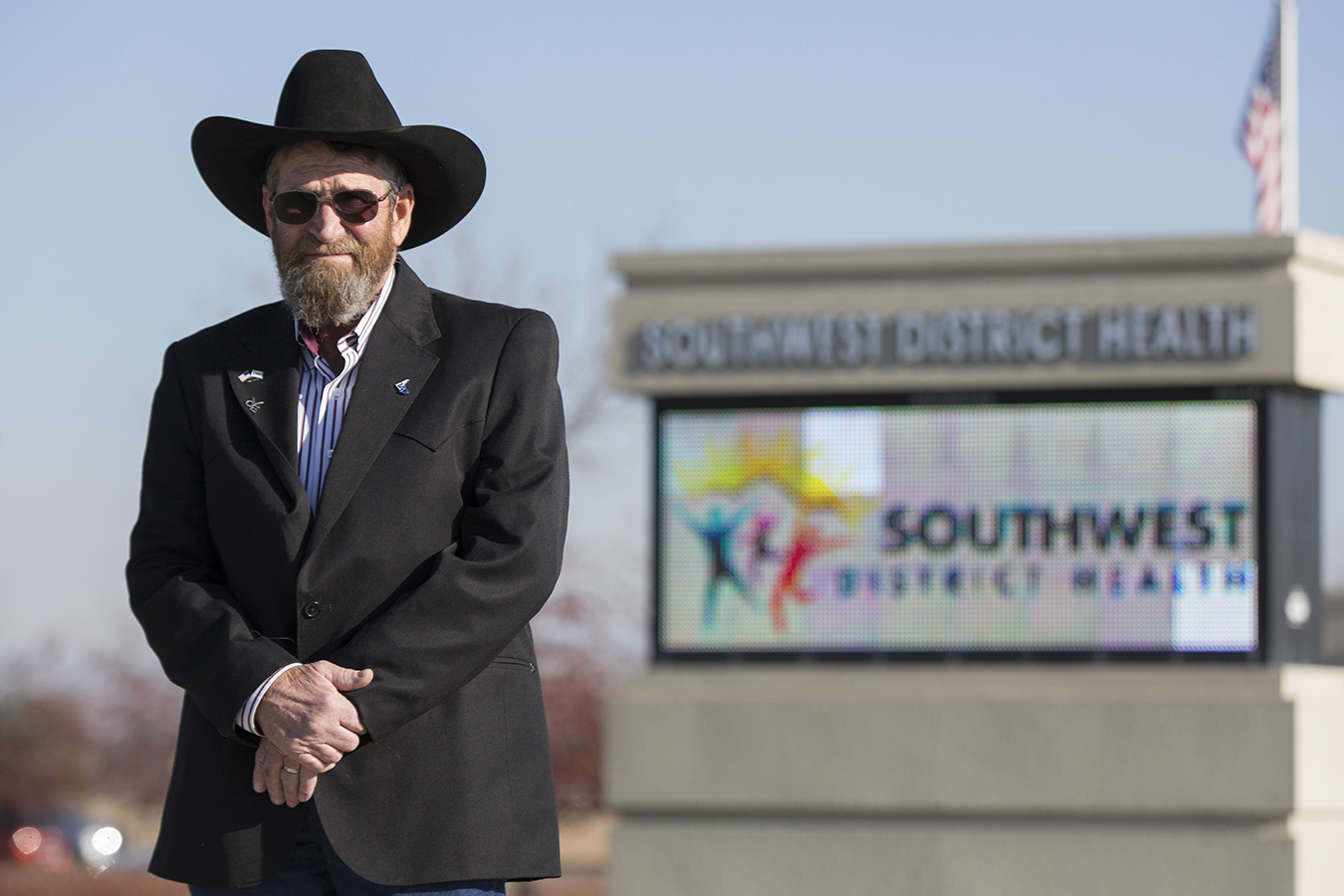
"I don't believe in mandates. I would never push a mandate on anyone. My job as an elected official is: Do what the citizens want. The citizens in my county are at least — at least — 80% would be against mandating masks. …
“You have a whole bunch of citizens out here that do not trust what's going on right now and are very confused at what's going on, because none of it makes sense because the information is not consistent. …
“Do I like my doctor? Do I think he does a great job? Absolutely. Do I trust what the medical field puts out there? No.”(AP Photo/Otto Kitsinger)
The Mask Fight in Kansas
The public health workforce in Kansas has been hit hard — 17 of the state’s 100 health departments have lost their leaders since the end of March.
Democratic Gov. Laura Kelly issued a mask mandate in July, but the state legislature allowed counties to opt out. A recent Centers for Disease Control and Prevention report showed the 24 Kansas counties that had upheld the mandate saw a 6% decrease in COVID-19, while the 81 counties that opted out entirely saw a 100% increase.
Coleman, who pushed unsuccessfully for Linn County to uphold the rule, was sued for putting a community member into quarantine, a lawsuit she won. In late November, she spoke at a county commissioner’s meeting to discuss a new mask mandate — it was her first day back in the office after her own bout with COVID-19.
She pleaded for a plan to help stem the surge in cases. One resident referenced Thomas Jefferson, saying, “I prefer a dangerous freedom over a peaceful slavery.” Another falsely argued that masks caused elevated carbon dioxide. Few, besides Coleman, wore a mask at the meeting.
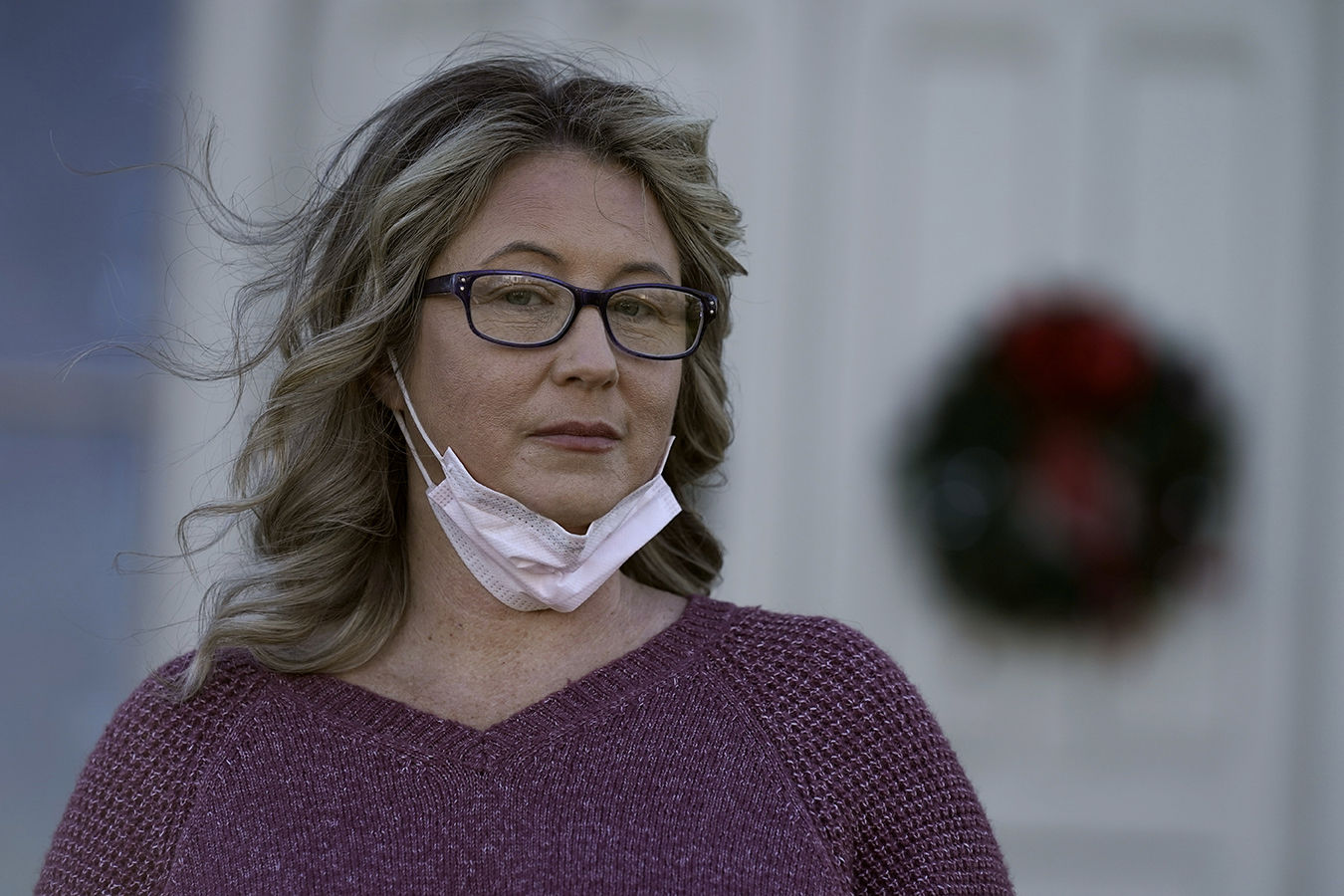
“It’s frustrating because we are the professionals, as far as what’s health-related, and that’s our job. ...
“We’re a small community and I’d say politics has been a big part of this. … Everyone has an opinion, and their opinion is gold. And there’s so much misinformation out there that people just grasp onto the misinformation and run with it. ...
“I just want people to understand we are human, too, we have feelings, too. And we are doing the best that we can with the information that we have and trying to protect and keep people safe.” (AP Photo/Charlie Riedel)
Commissioner Mike Page supported the mask order, noting that a close friend was fighting COVID-19 in the hospital and saying he was “ashamed” that members of the community had sued their public health workers while other communities supported theirs.
In the end, the commissioners encouraged community members to wear masks but opted out of a county-wide rule, writing they had determined that they are “not necessary to protect the public health and safety of the county.”
Coleman was disappointed but not surprised. “At least I know I’ve done everything I can to attempt to protect the people,” she said.
The next day, Coleman discussed Christmas decorations with her mother as she drove her to the hospital.
Stripping of Powers
The state bill that let Linn County opt out of the governor’s mask mandate is one of dozens of efforts to erode public health powers in state legislatures across the country.
For decades, government authorities have had the legal power to stop foodborne illnesses and infectious diseases by closing businesses and quarantining individuals, among other measures.
When people contract tuberculosis, for example, the local health department might isolate them, require them to wear a mask when they leave their homes, require family members to get tested, relocate them so they can isolate and make sure they take their medicine. Such measures are meant to protect everyone and avoid the shutdown of businesses and schools.
Now, opponents of those measures are turning to state legislatures and even the Supreme Court to strip public officials of those powers, defund local health departments or even dissolve them. The American Legislative Exchange Council, a corporate-backed group of conservative lawmakers, has published model legislation for states to follow.
Lawmakers in Missouri, Louisiana, Ohio, Virginia and at least 20 other states have crafted bills to limit public health powers. In some states, the efforts have failed; in others, legislative leaders have embraced them enthusiastically.
Tennessee’s Republican House leadership is backing a bill to constrain the state’s six local health departments, granting their powers to mayors instead. The bill stems from clashes between the mayor of Knox County and the local health board over mask mandates and business closures.
In Idaho, lawmakers resolved to review the authority of local health districts in the next session. The move doesn’t sit right with Aberasturi, who said it’s hypocritical coming from state lawmakers who profess to believe in local control.
Meanwhile, governors in Wisconsin, Kansas and Michigan, among others, have been sued by their own legislators, state think tanks or others for using their executive powers to restrict business operations and require masks. In Ohio, a group of lawmakers is seeking to impeach Republican Gov. Mike DeWine over his pandemic rules.
The U.S. Supreme Court in 1905 found it was constitutional for officials to issue orders to protect the public health, in a case upholding a Cambridge, Massachusetts, requirement to get a smallpox vaccine. But a 5-4 ruling last month indicated the majority of justices are willing to put new constraints on those powers.
“It is time — past time — to make plain that, while the pandemic poses many grave challenges, there is no world in which the Constitution tolerates color-coded executive edicts that reopen liquor stores and bike shops but shutter churches, synagogues, and mosques,” Justice Neil Gorsuch wrote.
Gostin, the health law professor, said the decision could embolden state legislators and governors to weaken public health authority, creating “a snowballing effect on the erosion of public health powers and, ultimately, public’s trust in public health and science.”
Who's Left?
Many health officials who have stayed in their jobs have faced not only political backlash but also threats of personal violence. Armed paramilitary groups have put public health in their sights.
In California, a man with ties to the right-wing, anti-government Boogaloo movement was accused of stalking and threatening Santa Clara’s health officer. The suspect was arrested and has pleaded not guilty. The Boogaloo movement is associated with multiple murders, including of a Bay Area sheriff deputy and federal security officer.
Linda Vail, health officer for Michigan’s Ingham County, has received emails and letters at her home saying she’d be “taken down like the governor,” which Vail took to be a reference to the thwarted attempt to kidnap Democratic Gov. Gretchen Whitmer. Even as other health officials are leaving, Vail is choosing to stay despite the threats.
“I can completely understand why some people, they’re just done,” she said. “There are other places to go work.”
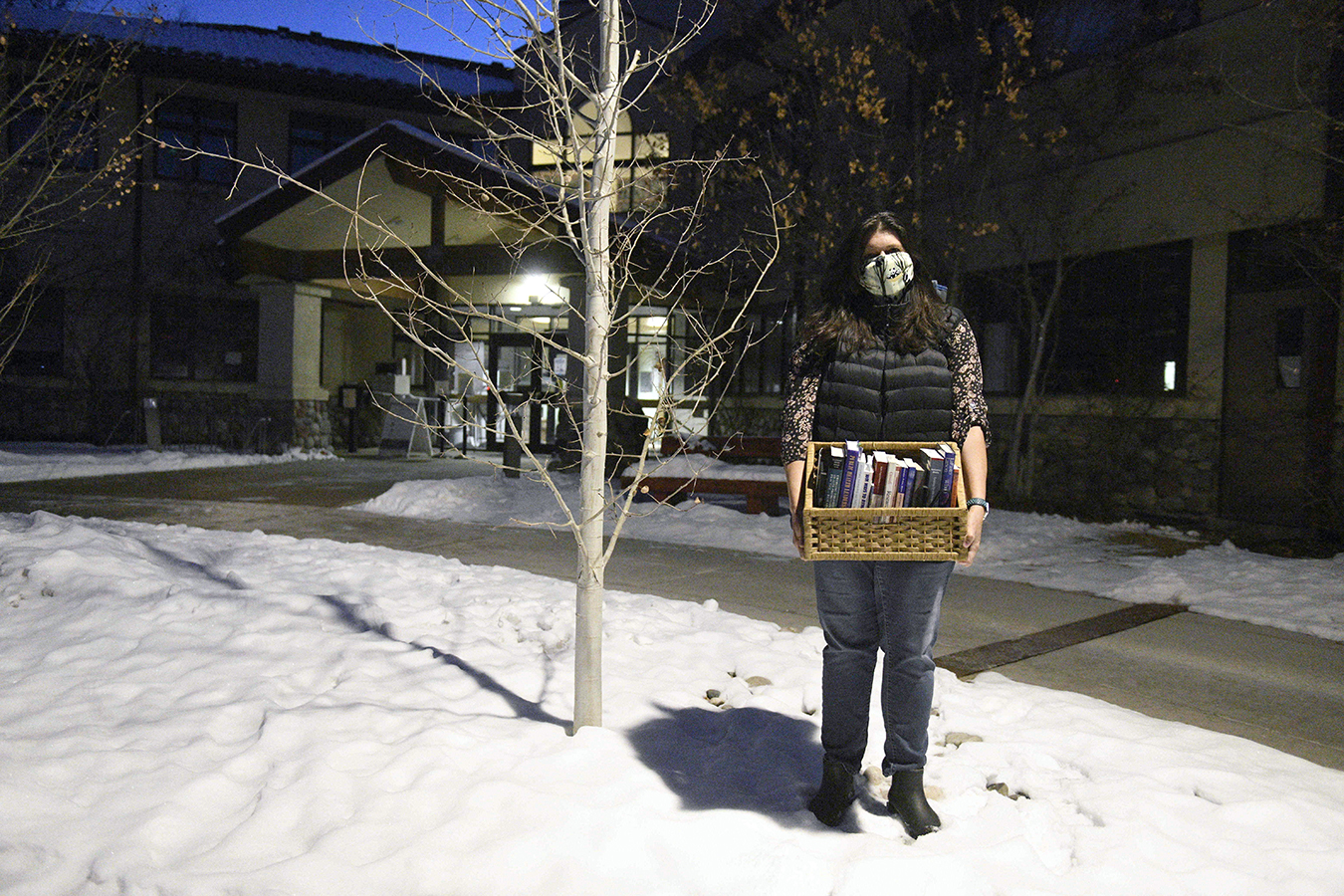
“I have been working eight months, 12 hours a day, seven days a week — I’m really burnt out, really burnt out. ...
“I think of the pandemic as the ultramarathon that we were required to do at a sprint’s pace. And we walked into that ultramarathon emaciated, we didn’t train well for it, we didn’t have the strength going in. ...
“Every day I do the best I can and I am giving so much, so much of myself to this job and this community. And all I get is criticism and it just was like, ‘Why am I doing this?’ Life is too short.” (Kelsey Brunner for KHN)
In mid-November, Danielle Swanson, public health administrator in Republic County, Kansas, said she was planning to resign as soon as she and enough of her COVID-19-positive staff emerged from isolation. Someone threatened to go to her department with a gun because of a quarantine, and she’s received hand-delivered hate mail and calls from screaming residents.
“It’s very stressful. It’s hard on me; it’s hard on my family that I do not see,” she said. “For the longest time, I held through it thinking there’s got to be an end in sight.”
Swanson said some of her employees have told her once she goes, they probably will not stay.
As public health officials depart across the country, the question of who takes their places has plagued Dr. Oxiris Barbot, who left her job as commissioner of New York City’s health department in August amid a clash with Democratic Mayor Bill de Blasio. During the height of the pandemic, the mayor empowered the city’s hospital system to lead the fight against COVID-19, passing over her highly regarded department.
“I’m concerned about the degree to which they will have the fortitude to tell elected officials what they need to hear instead of what they want to hear,” Barbot said.
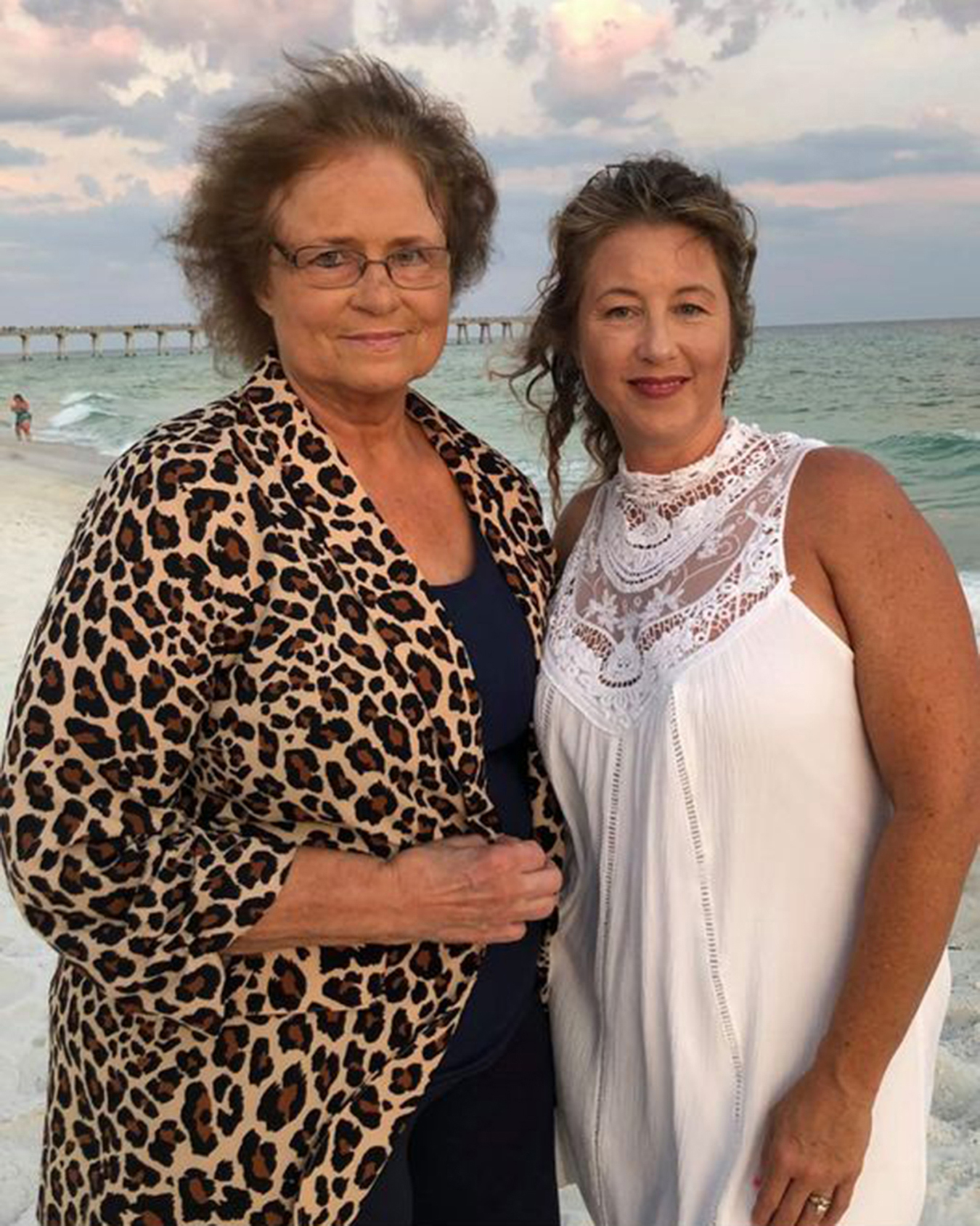
In Kentucky, 189 employees, about 1 in 10, left local health departments from March through Nov. 21, according to Sara Jo Best, public health director of the Lincoln Trail District Health Department. That comes after a decade of decline: Staff numbers fell 49% from 2009 to 2019. She said workers are exhausted and can’t catch up on the overwhelming number of contact tracing investigations, much less run COVID-19 testing, combat flu season and prepare for COVID-19 vaccinations.
And the remaining workforce is aging. According to the de Beaumont Foundation, which advocates for local public health, 42% of governmental public health workers are over age 50.
Back in Linn County, cases are rising. As of Dec. 14, 1 out of every 24 residents has tested positive.
The day after her mother was put on a ventilator, Coleman fought to hold back tears as she described the 71-year-old former health care worker with a strong work ethic.
“Of course, I could give up and throw in the towel, but I’m not there yet,” she said, adding that she will "continue to fight to prevent this happening to someone else.”
Coleman, whose mother died Sunday, has noticed more people are wearing masks these days.
But at the family hardware store, they are still not required.
This story is a collaboration between The Associated Press and KHN.
Methodology
KHN and AP counted how many state and local public health leaders have left their jobs since April 1, or who plan to leave by Dec. 31.
The analysis includes the exits of top department officials regardless of the reason. Some departments have more than one top position and some had multiple top officials leave from the same position over the course of the pandemic.
To compile the list, reporters reached out to public health associations and experts in every state and interviewed hundreds of public health employees. They also received information from the National Association of County and City Health Officials, and combed news reports and public records, such as meeting minutes and news releases.
The population served by each local health department is calculated using the Census Bureau 2019 Population Estimates based on each department’s jurisdiction.
The count of legislation came from reviewing bills in every state, prefiled bills for 2021 sessions, where available, and news reports. The bills include limits on quarantines, contact tracing, vaccine requirements and emergency executive powers.



